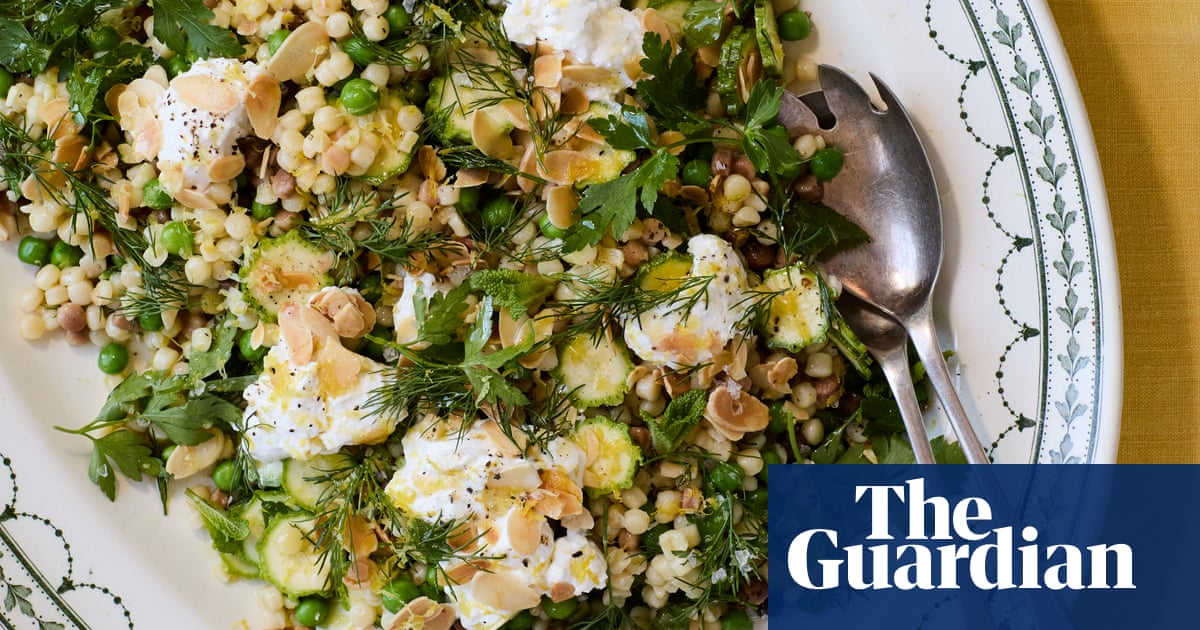To the northern eye, attuned as it is to the muted and russet tones of our indigenous apples and pears, the lemon is a thing of almost mocking brightness and jollity – so bold, blatant and exclamatory in its yellowness. Lemons are variously described as electric, fresh, optimistic, uplifting, zesty, spritzy, cheerful, sunny, lively. They are synonymous with freshness and optimism, and a happy lemon is full, pert and perky, and unapologetically, proudly yellow. Long live the lemon!
Fregola is a Sardinian pasta made by rolling grains of semolina together to form small balls, then roasting them in an oven. The finished pasta has a toasty, smoky flavour, a wonderful, nubbly texture and is just small/large enough to provide a nutty chew. It is versatile and delicious, and can be cooked like rice or pasta. Here, it is boiled like pasta and left to cool before becoming the basis of a substantial salad. The smokiness works well with the sweetness of young raw courgettes, while toasted almonds top everything off. This is a great side dish for roast fish or white meat, or a nice summer salad on its own.
Prep10 minCook20 minServes4as a side
250gfregolaSea salt and black pepper150gfrozen peas50-60mlextra-virgin olive oil, plus extra to serveFinely grated zest and juice of 1 lemon3 small courgettes, sliced or peeled into strips1 handfulsweet herbs(mint, parsley, dill), roughly chopped, plus extra to serve150gfresh ricotta40gflakedalmonds, toasted
Cook the fregola in a large saucepan of boiling salted water for about eight to 10 minutes, until al dente, adding the frozen peas to the pan a minute before the fregola is done. Once the pasta is cooked, drain and rinse quickly under cold running water. Drain again and put in a bowl to cool, stirring occasionally to prevent the fregola sticking together. When the fregola has cooled, season it well with salt, plentiful olive oil and lemon juice and zest, then taste for seasoning and adjust accordingly (the fregola will drink up the oil).
Toss the courgette ribbons through the cooled fregola and pea mixture, then add a little more seasoning if necessary. Toss through the herbs, then arrange on a platter and top with large blobs of ricotta. Sprinkle over some more roughly chopped herbs and the almonds, drizzle with a little extra oil to finish, then serve.
At one of my favourite restaurants of all time,the Seahorse in Dartmouth, Devon, a small silver dish of sliced fennel baked in cream is often served alongside baked white fish. The fennel is pale, delicate, sweet and savoury, and provides the perfect accompaniment. It looks beautiful, too, in all of its elven, pale green-white splendour. This is a gilded version of that same dish, lifted by a double hit of lemon and given a savoury punch by garlic and anchovies; if you prefer to keep it vegetarian, leave out the anchovies and it will still be delicious (you might also like to add a few roasted almonds, for extra savouriness and crunch). This can be a meal in itself (with a sharp, lemon-dressed green salad, say) or a side for pork, chicken or fish.
Prep10 minCook1 hrServes4-6
Butter, for greasing2 large or 3 small fennel bulbs(about 1kg)Sea salt300mldoublecream50mlmilk1 lemon, zested and quartered1 garlic clove, peeled and bashed80ggrated pecorino(make sure it’s a vegetarian one, if need be)30gcoarse breadcrumbs, preferably from a rustic loaf (dried breadcrumbs would also work)Extra-virgin olive oil, for drizzling6 anchovy fillets(optional)
Heat the oven to 190C (170C fan)/375F/gas 5, and grease a large gratin dish with butter.
Trim the roots and stems from the fennel bulbs, chop off and reserve the fronds, then slice the bulbs lengthways into 3mm- to 4mm-thick slices. Bring a pan of well-salted water to a boil, drop in the sliced fennel and cook for three minutes, until just tender. Drain, dry and arrange in the gratin dish.
Meanwhile, in a saucepan, heat the cream and milk with half the lemon zest, a pinch of salt, the chopped reserved fennel fronds and the bashed garlic clove. When it comes to a boil, take off the heat and stir in half the pecorino, until melted.
Chop one of the lemon quarters into thin slices, then chop these into little pieces and scatter all over the fennel. Pour over the cream mixture, and remove and discard the bashed garlic.
Mix the remaining lemon zest with the breadcrumbs and remaining cheese, sprinkle this over the fennel and cream, and drizzle with the olive oil. Dot over the anchovy fillets, if using, then bake for about 40 minutes, until golden and bubbling.
These recipes are edited extracts from For the Love of Lemons: Italian-inspired Sweet and Savoury Recipes, by Letitia Clark, published by Quadrille at £28. To order a copy for £25.20, go toguardianbookshop.com
